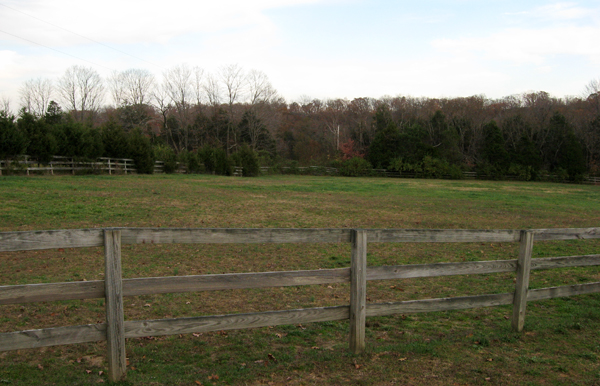I fear fertilizer more than sugar for my laminitic horses

The upper pasture by my house.
The question on my mind for weeks has been whether to fertilize my two upper pastures.
I’ve been digging online for information on grass content and sugar levels in trying to quell my fear of fertilizer.
I keep finding more laminitis researchers who believe fertilizer is a good thing for laminitic horses because it keeps grass from getting stressed, thus preventing sugar levels in the grass from spiking. But I am not convinced that this is the right strategy.
I have dug up some interesting statistics on horses eating grass that have helped me come to a conclusion for my own horses. I’m not suggesting that others follow my lead. Each of us has to make decisions for our own horses.
Numerous environmental factors — cool temperatures, short day length, intense sunlight, drought, and limited nutrients — raise the sugar levels of grass.
Finding a definitive number for how much these factors stress the plant and increase sugar levels is difficult, but Australian researcher Chris Pollitt suggests the sugar levels in grass can triple under stress.
Modern grasses have more sugar content than their predecessors, according to plant experts, who say this is intentional. Grass companies have “improved” grass to beef up cows, not to feed horses. The higher sugar content allows grass to recover faster after grazing, as well as to grow in cooler temperatures and to stand up better in drought.
Fertilizing a pasture can lower the sugar levels in the grass, because the grass uses its sugar to grow, but fertilizing also creates more grass, possibly giving the horse more sugar in the end and certainly more calories.
The prevailing advice these days appears to be fertilize the grass so you have healthy grass but limit your horse’s time on the grass.
That seems completely backward to me. I want my horses out all the time, moving, keeping busy, exercising and looking for food. But I want them to have less grass with lower sugar, and no one is providing that product. How is it that some enterprising person has not made a low-calorie, low-sugar grass for horses yet?
Ray Geor, the chairman of Large Animal Clinical Sciences at the College of Veterinary Medicine at Michigan State University, looked at the calorie intake and exercise of horses on pasture in an article on thehorse.com in 2003.
While the data is not new, Geor provides some interesting statistics, and I can’t think of any reason why these numbers wouldn’t hold up today:
— Horses spend about 10 percent of their time walking when on pasture.
— Horses spend more time walking on pasture if the pasture is of poorer quality or the horse is alone.
— Horses graze approximately 70 percent of the time when they are on pasture, so, if a horse has 24-hour access to pasture, it will spend up to 17 hours grazing.
— Grazing time is inversely proportional to the quality and amount of pasture forage, as in a horse will spend less time grazing a lush pasture compared to a dry pasture with lower forage availability (still, I would suggest the horse likely takes in far more food on the lush pasture).
— The amount of exercise depends on the amount of time in pasture. Horses grazing for 17 hours per day have been measured traveling 8 to 9.5 miles, while those out for seven hours have gone 2.5 to 3 miles.
— A 1,000-pound horse eats about 1 to 1.4 pounds of grass per hour (dry matter) if the grass is not limited.
— Orchard grass contains about 1,000 calories per pound.
Doing a little math based on Geor’s numbers, I believe that if a horse were out for 10 hours and grazed 70 percent of the time, or seven hours, on good grass, it may consume 7,000 to 9,800 calories per day. The National Research Council suggests that a 1,000-pound horse out of work should have about 15,000 calories per day, so a horse stuffing its face on grass for seven hours would still need some hay at the end of the day.
A horse on sparse grass — which some would shun as “stressed grass” higher in sugar — would get fewer calories and walk more, but the sugar level might be three times higher.
I’m thinking that three times the amount of sugar in a lot of grass equals a lot of sugar, but three times the amount of sugar in sparse grass is not so much sugar.
Beyond the sugar levels being affected by stress, they also fluctuate at different times of the day, spiking in the late afternoon.
Given the countless variables, I think it’s safe to say that trying to monitor or even guess the sugar levels in grass is a futile exercise for the average horse owner.
What I can control is the amount of grass I create, and, given the statistics I read in Geor’s article, I feel like having the horse walk more to eat less grass, stressed or not, is the better deal. It’s highly unlikely that I’m going to fertilize my pastures.